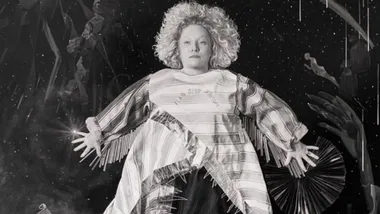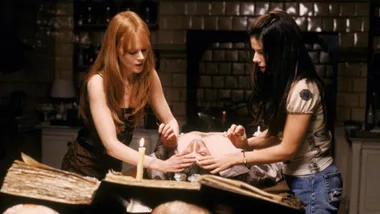Dressed neatly in a plain white T-shirt and wrap skirt, Melanie Greenwood props her phone on the windowsill in the hallway of her home in Holland Park West, Brisbane, and presses record. Joined by her 14-year-old niece, Macey, she starts bopping about to techno beats, giggling through a short choreographed dance routine. The performance is far from perfect, and at one point Melanie’s husband walks into the shot looking baffled.
Afterwards, the 36-year-old mum-of-two posts the video on TikTok without much thought – she’s recently joined the app at the insistence of her social-media-obsessed niece.
Fast forward 24 hours and the clip has been watched by more than two million users worldwide. Two days later, it jumps to five million views.
That was in December 2019, and today the video stands at more than nine million views. “It increases every few days,” says Melanie, a former beauty salon owner who goes by the handle @melgreenwoodbeauty83. “I still don’t know why it went viral.”
For the uninitiated, TikTok is the latest social media app to take grip. Created in 2017 by Chinese company ByteDance, it’s the fastest-growing video-sharing platform in the world. Last year it was the second most downloaded app globally. It now has almost 2 billion users in 154 countries.
First in, best dressed were, quite naturally, tech-native teens and tweens. After all, TikTok offers micro-doses of entertainment – users create and share videos that last just 15 seconds – perfect for attention-deficit gen-Zers. It also trades largely on participation. TikTok users challenge each other with dance routines or lip-syncing over sound bites. It might be some hip-dipping choreography to a retro Mariah Carey track (which gets particularly meta when Mariah joins the challenge); acting out a sequence of emojis with one’s hands; or high-kicking a cap off a drink bottle. Each challenge rises seemingly from nowhere, then sweeps through the app like wildfire before vanishing.
Melanie’s viral video was one such challenge: a dance routine comprised of eight simple moves to Russian dance song “Rakurs & Ramirez Remix”. A fellow 646,000 users also participated, but it was her video that made the For You landing page (nobody on the internet can work out how the algorithm behind this page works and, make no mistake, they’ve tried). She’s now, in her own right, a TikTok star, posting three times a day in between looking after daughters, Chloe, eight, who has the rare genetic disorder Koolen-de Vries Syndrome, and Charlotte, three. “It sure breaks up the monotony of being home all day with the kids,” she says. It also gives her a little buzz when, say, a recent 15-second clip of her standing in front of a mirror, rotating her phone, aka the #rotationchallenge, attracted a mind-blowing 270,000 views.
Two things are surprising here: one, how unremarkable most of the platform’s viral videos are; and two, that Melanie is not a rare fish in the teenage waters of TikTok. She’s one of a rising group of mothers who appear utterly unabashed as they churn out countless videos of themselves dancing and lip-syncing, playfully serving up comedy bits and memes.
For mum-of-two Keiara Moore (@aussiemumvlogger), a major part of the app’s appeal is its ease of use. A single video to her 44,000 YouTube subscribers – where she’s been vlogging since her daughter Mila was born with a cleft palate in 2017 – takes a few days to create, whereas even a more ambitious TikTok video takes just minutes. “And the engagement is much higher,” explains Keiara, also mum to 18-month-old Lincoln. She attracts about 8000 views per vlog, but a video of her dancing in the living room of her home in Kingscliff, NSW, to Gloria Gaynor’s “I Will Survive” was recently viewed over 120,000 times.
To date, videos with the hashtag #mumlife and #momlife have amassed a whopping 3.3 billion views. And #tiktokmum and #tiktokmom are at 177.4 million. That means the app’s largest user base, the under-24s, are actively seeking out their content.
“It reminds me of dancing around my living room with my sister when I was a kid. Very carefree,” explains 26-year-old Keiara. “And what I’ve noticed is that everyone seems to be celebrating each other. I’ve seen very little negativity and trolling.”
Divorced mum-of-one Donna Clarke (@tiktokaussiemum) has striking red hair and towers at six-foot tall. She says her “fans” are mostly teens, who celebrate the 45-year-old part-time model as she attempts routines to the likes of Hailee Steinfeld’s “Starving”, or when she parades in a pink polka-dot bikini to Dej Loaf’s “Back Up” in the bedroom of her Gold Coast home. “I get a lot of comments from the kids saying my figure is amazing,” shares Donna. “They can’t believe I’ve had a child.” Her videos, posted almost every day, can attract nearly half a million views. But what does her 17-year-old son Kai think? “He’s only interested in his friends these days,” she shrugs.
In September last year, Reese Witherspoon made her TikTok debut. In a behind-the-scenes video shared on Instagram, she asks her 16-year-old son, Deacon, to teach her “what TikTok is”. Then she learns to “hit the woah” – a teen phenomenon that involves making a quick circular motion with one’s fists, and freezing when the beat drops (think dabbing 2.0).
Her attempt is awkward and mumsy, yet charming, and Deacon’s reaction seems to be a mix of embarrassed and endeared – which might reflect the views of his fellow gen-Zers watching these videos on repeat.
According to social media expert Laurel Papworth, humour is what attracts these mums to TikTok in the first place. “It’s goofy and a bit of comic relief,” Papworth explains. “Instagram is about perfection – which can be exhausting for mums – always showing their best self. But TikTok is about kicking off your shoes and letting your hair down.” There’s no pressure to create content that’s filtered, Facetuned and flawless.
This is what lured Dannii Reed (@mummyrepublic) to TikTok late last year. The Brisbane-based mum-of-two’s Instagram account is posed and poised, hooked off a successful podcast about the challenges mums face every day. But TikTok? “I feel like I can show the more fun side of me,” says Dannii, 32. And it’s working. A recent seven-second skit on her reaction to some unsolicited pregnancy advice attracted an eye-watering 434,000 views.
That said, Dannii is unlikely to turn her TikTok prowess into a professional endeavour any time soon. In contrast to YouTube, TikTok doesn’t share ad revenue, so the only true way to make money out of it is through brand deals, much like Instagram. And while #tiktokmums might be getting the views – and even the likes – users aren’t actually following them. Melanie scores nearly 500,000 likes for her videos, but her followers stand at a paltry 53,000. To put that into perspective, the world’s biggest TikTok star, teenager Charli D’Amelio, has more than 48 million followers.
Mums are usually the signifier that a trend is on the way out rather than on the way up, but TikTok may be the exception to the rule. Right now, with most of us holed up at home amid the COVID-19 pandemic, the platform’s popularity in general is surging, and celebrity mums from Jessica Alba to Courteney Cox have
now jumped on board, performing hilarious dance routines with their daughters and hamming up the role of “embarrassing mum”.
It’s not surprising that the app is peaking in this time of crisis. In fact, there might be something to learn from the original mums of TikTok. Whether caring for sick children or juggling work and family, most turned to the app for some release and relief. And now the rest of us are finally catching on: when the world outside seems uncertain and overwhelming, sometimes there’s nothing better to do than stay at home and dance.
Dance Mums
Your favourite A-listers are taking to TikTok with their cheesiest moves (and just a hint of irony).
This article originally appeared in the June 2020 issue of marie claire.










